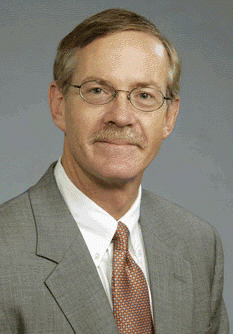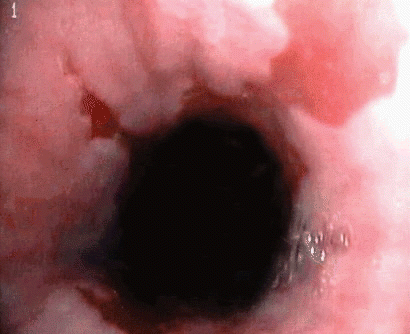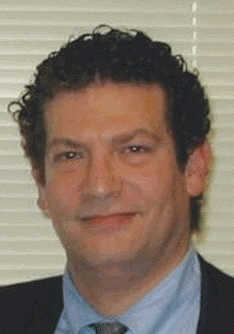Transnasal esophagoscopy (TNE) offers physicians and patients a number of advantages compared with conventional esophagoscopy (CE) performed transorally with sedation, and has become increasingly popular in clinical practice over the past several years.
The popularity of TNE began about seven or eight years ago with its introduction to the otolaryngology community, said Gregory Postma, MD, Director of Center for Voice and Swallowing Disorders and Professor of Otolaryngology at the Medical College of Georgia (MCG) in Augusta.
The procedure involves inserting an ultra thin endoscope through the nasal passages and into the esophagus. The endoscope provides excellent illumination and image quality, allowing full visualization of the esophagus, all while avoiding sedation as is necessary with CE, wrote Dr. Postma and his colleagues in a recent paper (Otolaryngol Head Neck Surg 2008;138:411-4).
It has become very popular, explained Dr. Postma. Most residency and training programs now use it, and TNE is still offered at various training courses.
 It has become very popular. Most residency and training programs now use it, and TNE is still offered at various training courses.
It has become very popular. Most residency and training programs now use it, and TNE is still offered at various training courses.-Gregory Postma, MD
Media coverage of TNE in the New York Times, Good Morning America, and other outlets over the past year has helped to increase the popularity of the procedure among patients, said Jonathan E. Aviv, MD, Clinical Director of the Voice and Swallowing Center at ENT and Allergy Associates in New York. Because esophageal cancer incidence is growing, physician and patients are looking for better ways to diagnose the disease, and TNE is one of most convenient and safe methods of doing so, he explained.
Indications
Although not yet proven, TNE is likely to lead to an earlier diagnosis of esophageal cancer, which will improve overall patient survival, noted Dr. Aviv, who is also a consultant for Medtronic and Vision Sciences. The disease is usually diagnosed after the patient starts experiencing swallowing problems, and by this time, the one-year mortality rate is 90%, he explained. However, if diagnosed early, about 90% of patients are alive after one year, he added.
In addition to screening for esophageal cancer, TNE is used to examine other pathologies of the esophagus, including reflux esophagitis and eosinophilic esophagitis, the latter of which is being recognized more frequently among young people, said Dr. Aviv.
Eosinophilic esophagitis is extremely common in patients with dysphagia due to allergies but is generally difficult to diagnose, added Dr. Aviv. However, with TNE, the physician can pass the endoscope into the esophagus and take esophageal biopsies to make the diagnosis, he explained.

Physicians also use TNE to assess dysphagia, caustic ingestions, and long-standing esophageal reflux symptoms, said Dr. Postma. Other indications include assessment of chronic cough, globus pharyngeus, laryngopharyngeal reflux, and esophageal varix follow-up, he said. TNE is also used in head and neck cancer patients to assess whether the esophagus is free of a second primary tumor, said Dr. Postma.
In patients with chronic reflux, TNE is used for the detection and surveillance of Barrett’s esophagus (BE) to ensure that the disease has not become cancerous, said Dr. Aviv. Why use conscious [intravenous] sedation? he questioned. In patients with proven Barrett’s esophagus, it’s an endoscopic evaluation of the esophagus that is critical, so conventional endoscopy under sedation isn’t necessary.
Even though TNE may help to detect BE, physicians are still uncertain of what type of treatment these patients should receive, noted Timothy Anderson, MD, of the Department of Otolaryngology/Head and Neck Surgery at the Lahey Clinic Voice Center in Burlington, MA. We don’t know for sure yet if we can cut down on rates or esophageal cancer by treating patients with Barrett’s esophagus, he said. However, one recent study (Shaheen NJ et al. NEJM 2009;360:2277-88) found that radiofrequency ablation of BE resulted in a high rate of complete eradication of dysplasia and intestinal metaplasia and reduced risk of disease progression.
In a 2002 retrospective database and chart review of 17 patients with presumed head and neck cancer (Laryngoscope 2002; 112:2242-3), Dr. Postma and his colleagues found that TNE provided 100% accuracy in biopsy results and staging of the tumor when compared with standard panendoscopy. The researchers also demonstrated the use of TNE in stricture dilation and secondary tracheoesophageal puncture in head and neck cancer patients.
Another recent study found that TNE can distinguish between functionally or anatomically related dysphagia and newly growing tumors in the upper digestive tract in patients who had recently undergone treatment for head and neck cancer (Wang CP et al. Oral Oncol 2009;45:615-20).
In addition to assessing a variety of esophageal and extraesophageal conditions, TNE can be used to remove esophageal foreign bodies, said Dr. Anderson. The foreign body can frequently be diagnosed and managed entirely in the office with TNE, he noted. Small, flexible objects such as fish bones are the easiest objects to remove, he said, adding that he has also taken out toothpicks, bay leaves, string, and French fries.
Thinner and more specialized instruments placed through working channels will one day enable physicians to use TNE to perform a variety of other esophageal interventions, although such instruments currently are not available, said Dr. Postma.
In addition to removing foreign bodies and performing biopsies of the laryngopharynx and esophagus, and ballooning strictures in the esophagus and neopharynx, secondary tracheoesophageal punctures are also commonly performed, said Dr. Postma. Moreover, TNE endoscopes can also be used to deliver flexible lasers to lesions in the laryngopharynx and esophagus.
Recent advances such as narrow-band imaging (NBI) enhance visualization of vascular patterrns and can help practitioners to better find malignancies and premalignant changes in the esophagus, pharynx, and layrnx, said Dr. Postma. MCG is currently involved in a prospective study evaluating the use of NBI in the laryngopharynx and esophagus. The research is supported by the company that makes this optic filter technology.
For more information on recent studies on TNE indications, please see the sidebar.
Contraindications
Contraindications for TNE include a history of gastric or duodenal ulcer, said Dr. Aviv, adding that TNE does not effectively examine the affected portions of the stomach and duodenum. If patients have abdominal pain, early satiety, nausea, or a history of gastric or duodenal ulcer, they need a fully sedated esophagogastroduodenoscopy, he explained.
The use of anticoagulants, such as Coumadin or Plavix, is not a contraindication to TNE or biopsies with the 1.8 mm forceps, but the endoscopist must be certain to pass the endoscope atraumatically through the nose, noted Dr. Postma.
Advantages
One of the most significant advantages of using TNE is that it does not require sedation, which reduces the potential for adverse events, said Dr. Anderson. TNE may result only in the occasional mild nosebleed, he said.
TNE has virtually no complications, agreed Dr. Postma. Only one major adverse event, an esophageal perforation, has been reported in the literature (Zaman A et al. Gastrointest Endosc 1999;49:279-84), he explained.
In contrast, CE has been associated with multiple perforations or even deaths, said Dr. Postma. One recent study found that 67% of complications and 72% of mortalities during endoscopy with sedation were cardiopulmonary-related (Sharma VK et al. Gastrointest Endosc 2007;66:27-34).
TNE also saves time, said Dr. Anderson. The patient can come in, be examined, and discuss the findings in less than 30 minutes, he said, adding that CE with sedation requires a prolonged recovery from anesthesia.
TNE is also more cost-effective because it is performed in an office setting, said Dr. Aviv. In contrast, CE is performed in an operating room or endoscopy suite, he said.
TNE is much more affordable than CE performed transorally with sedation, agreed Dr. Postma, adding that the difference in cost is approximately $2000 per procedure. Esophagoscopy requires a longer procedure time, a recovery room, and recovery time, he and several colleagues explained in a recent paper (Otolaryngol Head Neck Surg 2008;138:411-14). Additionally, CE has associated medications, patient monitoring, and nursing costs, they wrote.
 Why use conscious [intravenous] sedation? In patients with proven Barrett’s esophagus, it’s an endoscopic evaluation of the esophagus that is critical, so conventional endoscopy under sedation isn’t necessary.
Why use conscious [intravenous] sedation? In patients with proven Barrett’s esophagus, it’s an endoscopic evaluation of the esophagus that is critical, so conventional endoscopy under sedation isn’t necessary.-Jonathan E. Aviv, MD
Loss in work time is also much less with TNE than with CE, said Dr. Postma. Patients undergoing TNE are able to go back to work after the exam is completed, and do not need someone to drive them to and from the procedure, thereby decreasing the secondary costs.
TNE also requires very little preparation from patients. Generally, they should not eat for three hours beforehand, said Dr. Aviv. If their stomach is full, they will likely regurgitate, making it difficult for physicians to see during the TNE, he explained.
Physicians should also ask that patients forgo blood thinners to avoid bleeding problems during the procedure, said Dr. Aviv. Dr. Postma, however, noted that this is not done at MCG.
Disadvantages
TNE is more of a screening and diagnostic modality than a treatment tool, explained Dr. Anderson. Patients may sometimes need follow-up surgery or a conventional esophagoscopy, he added. Dr. Postma noted, however, that needing CE after TNE is not very common.
One drawback of TNE is that it requires using a small scope, which limits the types of interventions that can be performed, said Dr. Anderson. TNE results in a smaller working channel and results in less control of foreign bodies, especially when compared with rigid esophagoscopy, he observed. If a patient undergoes sedated CE, physicians are able to use balloons through the endoscope to open any strictures they find, he said.
Although many therapeutic instruments are designed to fit through larger side channels, which are only available on standard CE systems, Dr. Postma and his colleagues often perform dilations with a balloon alongside the TNE scope.
Moreover, if significant time is required to perform a procedure, the physician may prefer to sedate the patient and use CE, he continued.
Overall, TNE has undergone a standard pattern of use, Dr. Anderson said. Early adopters find a new technology that they are excited about, and an increasing number of people use it; however, limitations soon become apparent and the enthusiasm fades, he explained. It’s a great tool, but it’s a diagnostic tool, and there are limits to what we can do with it, he concluded.
Recent Data on TNE Indications
Researchers have been evaluating the role of TNE in gastroenterology and otolaryngology, and have found the technology to be useful for a number of indications. Dr. Postma noted that all studies have found TNE and CE to be equal in diagnostic accuracy, and that patients prefer TNE to CE. Some of the more recent data follow.
Dr. Postma and his colleagues evaluated 711 consecutive cases undergoing TNE (Laryngoscope 2005;115(2):321-3) and found that the most frequent indications were esophageal reflux, globus, or dysphagia (n = 490), biopsy of the laryngopharynx, trachea, or esophagus (n = 42), screening of the esophagus in head and neck cancer (n = 45), and evaluation for an esophageal foreign body (n = 12). A tight nasal vault resulted in the inability to enter the esophagus in 17 procedures.
Half of the 592 individuals with reflux, dysphagia, or globus pharyngeus had significant findings, the most frequent being esophagitis (n = 98), hiatal hernia (n = 47), and Barrett’s esophagus (n = 27). Researchers concluded that TNE was well tolerated and safe and may replace radiographic imaging of the esophagus in patients with reflux, globus and dysphagia.
Another study (Laryngoscope 2005;115:993-6), of which Dr. Anderson was one of the authors, found that with appropriate selection criteria, TNE yields a high percentage of positive findings and wide range of esophageal abnormalities, directly impacting patient management.
In this retrospective chart review of 30 patients, physicians used TNE to assess dysphagia, gastroesophageal reflux or laryngopharyngeal reflux, or a new diagnosis of head and neck squamous cell carcinoma. Positive findings included mucosal cobblestoning, Barrett’s esophagus, esophagitis, gastritis, candidal esophagitis, esophageal diverticulum, postcricoid mass, patulous esophagus, and absence of secondary esophageal peristalsis, reported the study authors.
In a recent prospective study, researchers used TNE to evaluate the prevalence of esophageal pathology of 50 patients presenting with throat symptoms at a voice clinic and had the variability of findings reviewed by an otolarygoloist and a gastroenterologist (Falcone MT et al. Otolaryngol Head Neck Surg 2009;140:812-5). Hoarseness was found in 68% of patients, hiatal hernia in 32%, possible Barrett’s esophagus in 12%, esophagitis in 10%, and esophageal stricture in 10% of patients.
The percent agreement for a normal study was 72%, while the percent agreement for various pathological findings were 86% for Barrett’s esophagus, 88% for esophagitis, 76% for hiatal hernia, and 96% for esophageal stricture. For an abnormal study, the percent agreement was 80%.
©2009 The Triological Society
Leave a Reply